All-America Selections, after tabulating results from the 2019 trial season, announces seven new AAS Winners.
Each of the following new AAS Winners was trialed throughout North America by professional, independent, volunteer judges who grew them next to comparisons that are considered best-in-class. Only those entries that performed better than the comparisons are granted the AAS award designation.
This set of AAS Winners for the 2020 garden season are:
- Coleus Main Street Beale Street (National)
- Nasturtium Tip Top Rose (Regional)
- Pumpkin Blue Prince F1 (National)
- Tomato Apple Yellow F1 (National)
- Tomato Buffalosun F1 (Regional)
- Tomato Chef’s Choice Bicolor F1 (Regional)
- Tomato Crokini F1 (Regional)
The first AAS Winners for the 2020 garden season were announced this past summer:
- Cucumber Green Light F1 (National)
- Echinacea Sombrero Baja Burgundy (National)
- Rudbeckia American Gold Rush (National)
- Tomato Celano F1 (National)
- Tomato Early Resilience F1 (National)
- Tomato Galahad F1 (Regional)
- Watermelon Mambo F1 (National)
Growers, retailers and consumers will find these AAS Winners for sale as supply becomes available through the distribution chain.
Each AAS Winner is marketed through social media, public relations and trade shows and are proudly grown in 190 AAS Display Gardens across North America.
- AAS Display gardens can be found here.
- Retailers can request an All-America Selections Point-of-Purchase package from the AAS office.
- PowerPoint presentations are available on SlideShare or on the AAS website.
- Bench cards and variety markers can be downloaded from the AAS website.
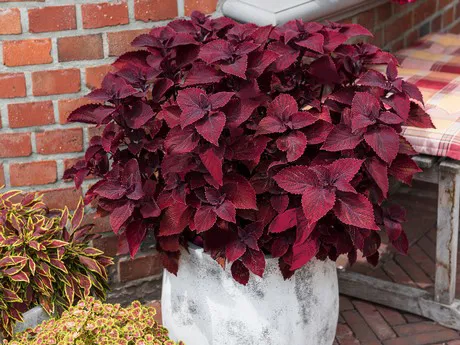
Coleus Main Street Beale Street
AAS Ornamental Vegetative Winner
National Winner
The first-ever coleus to be named an AAS Winner! Main Street Beale Street coleus is an outstanding variety exhibiting deep red foliage that holds its color extremely well in the garden. The rich color doesn’t fade, bleach or get spotty as the season moves into late summer. The lush, bushy plant grows uniformly and as a huge bonus, does not flower until very late in the season – up to 6 weeks later than the comparisons! A unique feature of this coleus is that it can be successfully grown from full sun to full shade, making it an ideal foliage item for anywhere in the garden. Growers, retailers, landscapers and homeowners will all appreciate the beautiful color and uniform height of this coleus.
(Click link for order contact)
https://na.dummenorange.com/site/en
AAS Winner Data
- Genus species: Solenostemon scutellarioides
- Common name: Coleus
- Flower color: NA
- Foliage color: Red
- Flower size: NA
- Plant height: 24-36 inches
- Plant habit: Upright, bushy
- Plant type: Annual
- Garden location: Full sun, Partial Sun or Shade
- Garden spacing: 12-16 inches
- Garden resistance: Heat, Rain, Wind
- Closest comparisons on market: Colorblaze Rediculous, Ruby Slipper
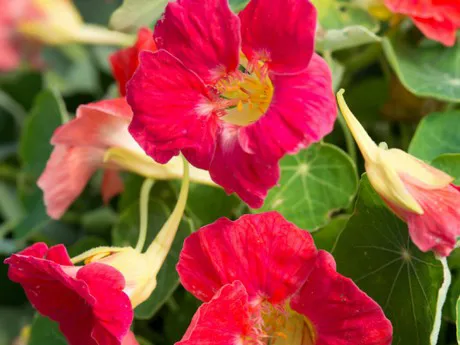
AAS Ornamental Seed Winner
Regional Winner – West/Northwest, Mountain/Southwest
Tip Top Rose is a strong yet compact nasturtium with unique and showy rose- colored flowers showcased above medium green foliage. These 14x18” mounded plants were more floriferous than the comparisons varieties in the AAS trials, producing a bigger and better garden show. The uniquely colored flowers are a great addition to the nasturtium family especially since they don’t fade as they age. Judges described the color as “a warm, bright rose with less of the black undertones typical in nasturtium flowers.” Tip Top Rose remained healthy throughout the season. It makes a great winter annual in warmer climates and a spring annual in other areas, whether used in containers or in the landscape. The whole plant stayed uniform and healthy whereas other varieties struggled. Bonus: This nasturtium is great for pollinator gardens and both the leaves and flowers are edible!
(Click link for order contact)
AAS Winner Data
- Genus species: Tropaeolum minus
- Common name: Nasturtium
- Flower color: Rose
- Foliage color: Green
- Flower size: 2 inches
- Bloom time: Summer to frost
- Plant height: 15 inches
- Plant type: Annual
- Garden location: Full sun to partial sun
- Garden spacing: 20 inches
- Weather tolerance: Rain, heat, cold, drought, wind
- Closest comparisons on market: Cherry Rose, Tip-Top Formula Mix
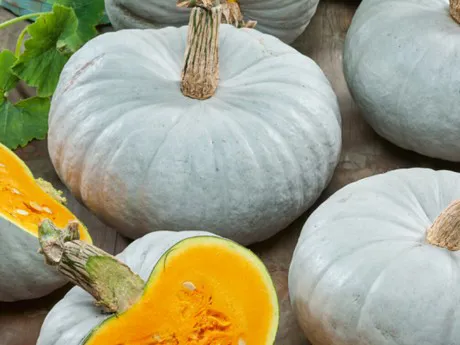
AAS 2020 Edible Winner
National Winner
“Princely” is defined as being sumptuous and splendid; this AAS Winner lives up to its name! For any edible entry to become an AAS Winner, it must outperform the comparisons and Blue Prince Pumpkin certainly scored high in the areas of maturity (earlier), yield, fruit size and uniformity, color, taste and texture. Vigorous trailing vines produce 7-9 beautiful blue flattened pumpkins with non-stringy, deep orange flesh with a savory sweetness. These pumpkins are as pretty as they are delicious. After fall decorating, bake the flesh for a smooth and creamy treat. Of all the varieties trialed, Blue Prince was first to flower and fruit which is beneficial for gardeners with a shorter growing season. Plus, this winner has slightly better disease resistance than the comparisons. A judge’s testimonial: “Overall, if I was looking for a blue pumpkin to display AND eat, I'd pick this entry every time!”
(Click link for order contact)
https://www.seedsbydesign.com/
AAS Winner Data
- Genus species: Cucurbita maxima
- Common name: Pumpkin
- Fruit size: 10-12 inches, 7-9 pounds
- Fruit shape: Flattened round
- Color: Light blue skin with bright orange flesh
- Plant height: 18 inches tall vines
- Plant habit: Trailing vines 5+ feet
- Garden location: Full sun
- Garden spacing: 1-2 feet
- Length of time to harvest: 110 days from seeding
- Disease resistance: PM tolerance, Southern root rot resistance
- Closest comparisons on market: Jarradale, Blue Harvest F1
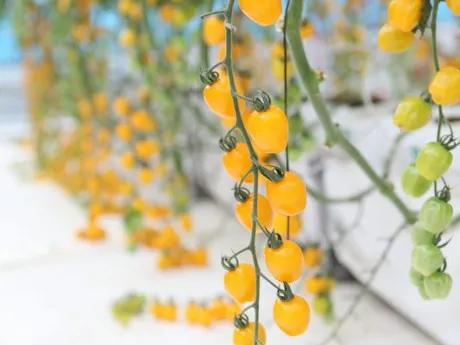
AAS 2020 Edible Winner
National Winner
If you’ve never tried an apple- shaped tomato, now is the time. This AAS Winner offers incredible garden performance, a uniquely dimpled apple-shaped fruit with a deliciously sweet citrusy taste and firm, meaty texture. Indeterminate 5’ tall vines produce abundantly in clusters, resulting in up to 1,000 fruits per plant. The fruits are an eye-catching, bright, lemon yellow color reminiscent of the “Big Apple’s” taxi-cab colors. Judges were excited that a non-splitting, long-holding, uniformly shaped tomato had such good eating quality. With just the right balance of sugar and acid flesh in a firm exterior, Apple Yellow would be perfect stuffed with a savory cheese for a delicious appetizer.
(Click link for order contact)
AAS Winner Data
- Genus species: Solanum lycopersicum
- Common name: Tomato
- Fruit size: Small apple shaped
- Fruit weight:7 ounces
- Color: Yellow
- Plant height: 5-6 feet
- Plant habit: Indeterminate, staking recommended
- Garden location: Full sun
- Garden spacing: 2 feet
- Days to harvest: 110-120 days
- Disease resistance: Tomato yellow leaf curl, Tomato mosaic 2A, Fusarium, Late blight, Bacterial wilt
- Closest comparisons on market: Golden Sweet F1
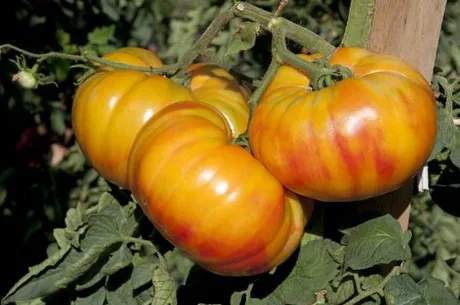
AAS 2020 Edible Winner
Regional Winner – Southeast and Northeast
All that an heirloom has to offer but better! Buffalosun shone in the trials with fruit that had a better texture than the comparisons (Margold and Striped German), a higher yield and less cracking. This indeterminate tomato should be staked for best garden performance and you will be rewarded with fruits long into the season. The unique yellow with red/orange flame coloration is beautiful on the outside and results in a nicely marbled interior. Good tasting sweet, tender flesh gives the look of an heirloom without the mushiness often associated with heirlooms. Buffalosun also outlasted the comparisons when disease hit in late summer, notably thanks to its late blight resistance.
Fun fact: Buffalosun exhibited good locule development. What’s a locule? That space between tomato sections where the seeds and gel are formed.
(Click link for order contact)
http://clausehomegarden.com/?language=en
AAS Winner Data
- Genus species: Solanum lycopersicum
- Common name: Tomato
- Fruit size: 4 x 2 inches, 18-20 ounces
- Color: Yellow with red flames
- Plant height: 5-6 feet
- Plant habit: Indeterminate, staking recommended
- Garden location: Full sun
- Garden spacing: 19 inches
- Length of time to harvest: 110 from sowing seed, 70 days from transplanting
- Disease resistance: High resistance: Fusarium:1,2,3; Verticillium albo-atrum wilt: 1; Verticillium dahliae:1 / Intermediate resistance: Late blight; Tomato Spotted Wilt: 0
- Closest comparisons on market: Margold F1, Striped German
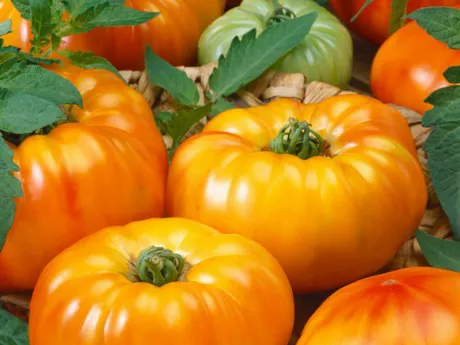
Tomato Chef’s Choice Bicolor F1
AAS 2020 Edible Winner
Regional Winner – Heartland
The first bicolor tomato in the Chef’s Choice series is here! Indeterminate plants produce large 7-8 ounce flattened beefsteak fruits with beautiful pinkish red internal stripes within a yellow flesh. The lovely stripes extend to the base of the outer fruit skins. These heirloom looking tomatoes are as sweet as they are beautiful with a better flavor and texture than the comparisons. Gardeners will enjoy earlier maturity and more uniform fruits that hold up all season long, producing well into September in the Heartland. As with all the colors in the Chef’s Choice series, each plant can produce about 30 fruits per season.
(Click link for order contact)
https://www.seedsbydesign.com/
AAS Winner Data
- Genus species: Solanum lycopersicum
- Common name: Tomato
- Fruit size: 5-6 inches, 7-8 ounces
- Fruit shape: Flattened round
- Color: Yellow fruit with pink/red internal stripes
- Plant height: 5 feet
- Plant habit: Indeterminate, staking recommended
- Garden location: Full sun
- Garden spacing: 12-14 inches
- Length of time to harvest: 75 days from transplant
- Disease resistance: Anthracnose, Scab, Tomato Mosaic Virus, Fusarium
- Closest comparisons on market: Margold F1, Old German
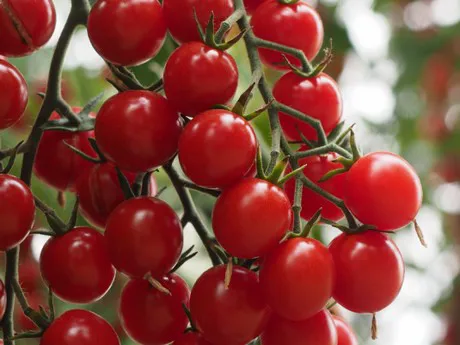
AAS 2020 Edible Winner
Regional Winner – Southeast
This rockin’ winner has a very sweet (Brix of 8.5), light acidic taste giving it the perfect sweet/acid balance. Pronounced like “rock” not “crook”, Crokini’s round fruits are small and firm with a crunchy texture and good flavor. This winner gets high marks for durability because fruits do not crack on the vine, yielding up to 10-12 fruits per cluster. Crokini provides a lovely burst of sweetness. Overall, the yield was better than comparisons because of the in-bred Late Blight resistance well into September. The Southern AAS Judges like the better taste and texture as compared to Sweet Million. Overall, Crokini is a “cleaner” plant because it is slightly more compact than comparisons with evenly distributed fruit.
(Click link for order contact)
http://clausehomegarden.com/?language=en
https://www.tomatocrokini.com/en/
AAS Winner Data
- Genus species: Solanum lycopersicum
- Common name: Tomato
- Fruit size: ½-3/4 inch, ½ ounce
- Fruit shape: Round
- Color: Red
- Plant height: 5-6 feet
- Plant habit: Indeterminate, staking recommended
- Garden location: Full sun
- Garden spacing: 19 inches
- Length of time to harvest: 100-105 from sowing seed, 60-65 days from transplanting
- Disease resistance: High resistance: Tomato mosaic virus:0,1,2; Fusarium wilt:0; Leaf mold:A,B,C,D,E / Intermediate resistance: Root-knot nematodes; Tomato yellow leaf curl; Late blight
- Closest comparisons on market: Sweet Million F1, Supersweet 100 F1
For more information: All-America Selections
All-America Selections
Diane Blazek
[email protected]
all-americaselections.org
